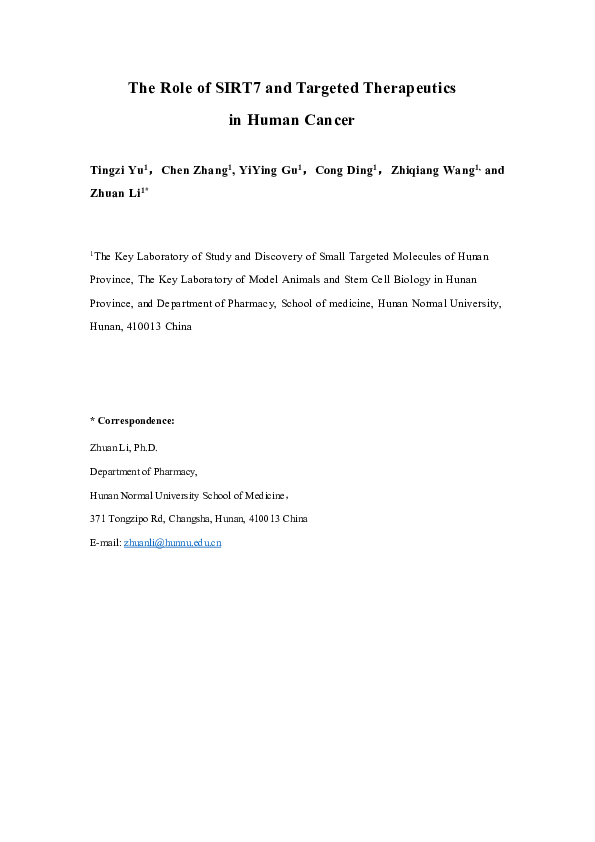Tingzi Yu
The Key Laboratory of Study and Discovery of Small Targeted Molecules of Hunan Province, The Key Laboratory of Model Animals and Stem Cell Biology in Hunan Province, and Department of Pharmacy, School of medicine, Hunan Normal University, Hunan, 410013 China
The Key Laboratory of Study and Discovery of Small Targeted Molecules of Hunan Province, The Key Laboratory of Model Animals and Stem Cell Biology in Hunan Province, and Department of Pharmacy, School of medicine, Hunan Normal University, Hunan, 410013 China
Chen Zhang
The Key Laboratory of Study and Discovery of Small Targeted Molecules of Hunan Province, The Key Laboratory of Model Animals and Stem Cell Biology in Hunan Province, and Department of Pharmacy, School of medicine, Hunan Normal University, Hunan, 410013 China
The Key Laboratory of Study and Discovery of Small Targeted Molecules of Hunan Province, The Key Laboratory of Model Animals and Stem Cell Biology in Hunan Province, and Department of Pharmacy, School of medicine, Hunan Normal University, Hunan, 410013 China
YiYingGu Gu
The Key Laboratory of Study and Discovery of Small Targeted Molecules of Hunan Province, The Key Laboratory of Model Animals and Stem Cell Biology in Hunan Province, and Department of Pharmacy, School of medicine, Hunan Normal University, Hunan, 410013 China
The Key Laboratory of Study and Discovery of Small Targeted Molecules of Hunan Province, The Key Laboratory of Model Animals and Stem Cell Biology in Hunan Province, and Department of Pharmacy, School of medicine, Hunan Normal University, Hunan, 410013 China
Cong Ding
The Key Laboratory of Study and Discovery of Small Targeted Molecules of Hunan Province, The Key Laboratory of Model Animals and Stem Cell Biology in Hunan Province, and Department of Pharmacy, School of medicine, Hunan Normal University, Hunan, 410013 China
The Key Laboratory of Study and Discovery of Small Targeted Molecules of Hunan Province, The Key Laboratory of Model Animals and Stem Cell Biology in Hunan Province, and Department of Pharmacy, School of medicine, Hunan Normal University, Hunan, 410013 China
Zhiqiang Wang
The Key Laboratory of Study and Discovery of Small Targeted Molecules of Hunan Province, The Key Laboratory of Model Animals and Stem Cell Biology in Hunan Province, and Department of Pharmacy, School of medicine, Hunan Normal University, Hunan, 410013 China
The Key Laboratory of Study and Discovery of Small Targeted Molecules of Hunan Province, The Key Laboratory of Model Animals and Stem Cell Biology in Hunan Province, and Department of Pharmacy, School of medicine, Hunan Normal University, Hunan, 410013 China
Zhuan Li*
The Key Laboratory of Study and Discovery of Small Targeted Molecules of Hunan Province, The Key Laboratory of Model Animals and Stem Cell Biology in Hunan Province, and Department of Pharmacy, School of medicine, Hunan Normal University, Hunan, 410013 China
The Key Laboratory of Study and Discovery of Small Targeted Molecules of Hunan Province, The Key Laboratory of Model Animals and Stem Cell Biology in Hunan Province, and Department of Pharmacy, School of medicine, Hunan Normal University, Hunan, 410013 China
# contributed equally to this work, * Corresponding
author
Abstract
SIRT7 is a NAD+-dependent class III histone deacetylases (HDAC III), which predominantly localized in the nucleus where it regulates RNA polymerase I transcription by deacetylating H3K18. SIRT7 has been implicated in multiple cellular functions including hepatic lipid metabolism, mitochondrial homeostasis and adipogenesis by targeting several non-histone proteins including p53, GABP-β, FOXO3 and U3-55k. In addition, emerging evidences have implicated SIRT7 in cancer development and progression. SIRT7 is important for maintaining the fundamental properties of the cancer cell phenotype and high SIRT7 levels are associated with metastatic disease and poor prognosis. Inactivate SIRT7 are shown to decrease cancer proliferation, metastasis and increase chemosensitivity in multiple cancer types which make SIRT7 to be an attractive therapeutic target for human cancer. In this review, we summarized recent advances in the roles of SIRT7 and new discoveries of targeting SIRT7 in human cancer.


